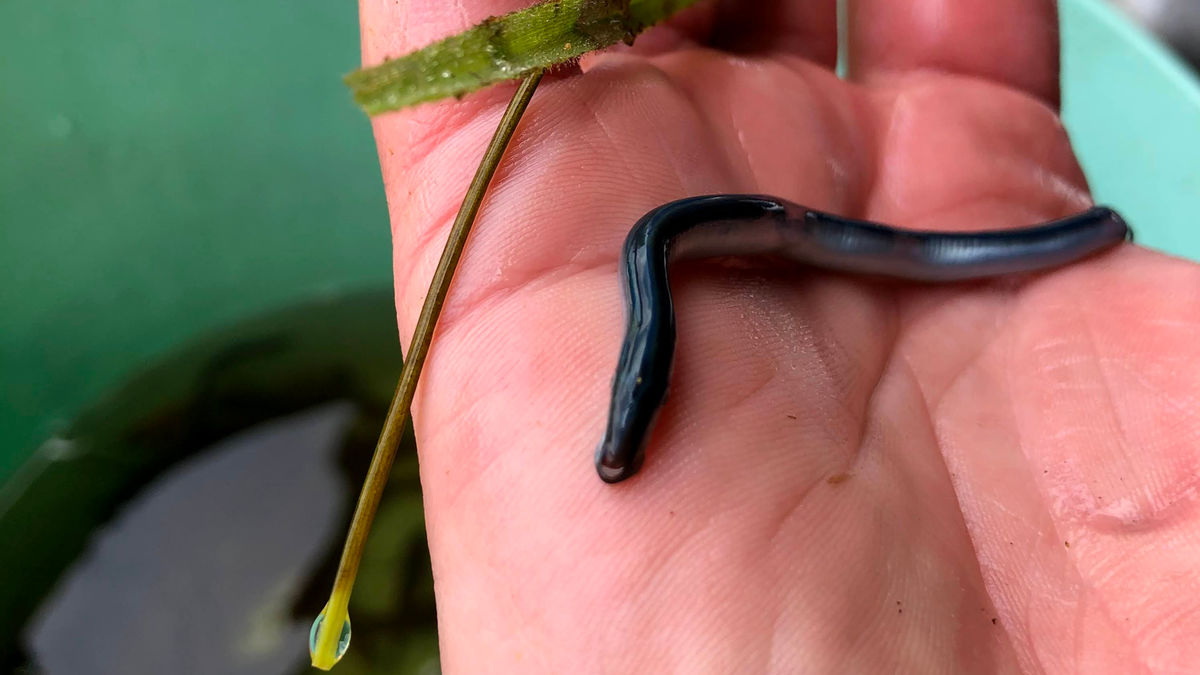
Fish survey and isotope analysis
What is the problem?
The annual fish survey in Waituna Creek has provided valuable information about the state of the lagoon and the freshwater habitats associated with it.
We wanted more data to confirm how fish populations are responding to in-stream habitat improvements that Living Water has made.
Not enough is known about what food sources fish consume and where they feed to inform decision-making about land use and waterway management and its impact on biodiversity. For example, we wanted to understand the contribution of upstream-migrating whitebait to the diet of eels and other piscivorous (fish-eating) fish.
What is the project?
Living Water (through the Whakamana te Waituna partnership) commissioned research from the Cawthron Institute to better understand the functioning of the freshwater food web in the Waituna catchment. Research questions included finding out what predatory fish (such as giant kōkopu, longfin eel and brown trout) are eating, whether they rely more on lagoon-derived or creek-derived food, and estimating the mass of īnanga consumed each year. These are important questions because some of the prey species require clean freshwater in the creek while others rely on brackish lagoon water to survive. All prey species require healthy ecosystems to live in. Predatory fish can’t grow as fast, or as big, and may not survive if the food sources they consume are threatened.
What was done?
Previous research identified multiple food sources in the lagoon and creek including macroinvertebrates (such as zooplankton, snails, mayflies and worms) and small fish (such as the common bully and īnanga). Finding out which fish are eating which food sources is possible thanks to the latest science of isotope analysis of tissue samples.
Different food items and habitat types have distinct isotope signatures. Macroinvertebrates living in the lagoon have an isotope signature distinct from that of macroinvertebrates living in the creek. It’s possible to analyse tissue samples from fish, to find out, broadly, what they have been eating and where it comes from. For example, the data showed that smelt and īnanga have the strongest reliance on food derived from the lagoon, whereas giant kōkopu consumed food from the creek.
The data from the analysis can be used to assign a trophic level (from 1-3.9) to each fish sampled to determine which food items or species are towards the bottom of the food web (primary consumers) and which ones are at the top (tertiary consumers such as brown trout and eel). For example, some longfin eels surveyed had a tropic level greater than 3, suggesting they were feeding on other tertiary consumers.

Pat Hoffmann

What did Living Water learn from the fish isotope analysis?
The isotope analysis provided a fascinating insight into the feeding habits of fish in the Waituna catchment. Smaller fish (common bully and īnanga) tended to rely on food derived from the habitat where they were collected. Bullies collected near the lagoon ate a higher proportion of lagoon food, while bullies collected further upstream ate a higher proportion of food from the creek. In contrast, larger longfin eels and trout ate a higher proportion of lagoon-derived food regardless of where they were caught. This included individuals caught 7.5km upstream.
The research estimated eels and trout consume approximately two tonnes of īnanga in the lower 7.5 kilometers of Waituna Creek each year. They might look small but those eels and trout are consuming an incredible volume of food. This matters because to successfully reproduce the īnanga need to move freely from the sea into the lagoon and up the creek. If the lagoon outlet is closed for prolonged periods that could disrupt their reproduction and threaten the food source, and therefore the survival, of eels and trout in Waituna.
Other findings from the research indicated food derived from the lagoon was more important for eels and trout, while the giant kōkopu relied on food in the creek. The food source for giant kōkopu also underwent a change in 2022. In previous surveys, giant kōkopu fed mostly on invertebrates, such as insects. The 2022 research was conducted during a drought when water levels in Waituna Creek were the lowest in recorded history. In the drought year, the giant kōkopu in the creek ate more īnanga. That’s because the larger eels that normally feed on īnanga had disappeared from the creek possibly in search of deeper water in the lagoon. With no eels around the giant kōkopu had free rein to eat the īnanga as they migrated upstream from the lagoon.
The drought also impacted where some fish species were located. As water levels in Waituna Creek dropped there was very limited natural habitat available for giant kōkopu. All the giant kōkopu caught in the study were found underneath or around the habitat structures that Living Water installed in the lower Waituna Creek as part of a restoration project. Beneath the surface of the creek manuka bundles and logs were anchored to the creek’s bed to create safe habitat and riffles in the water, to attract fish and invertebrates. These habitat structures were where the giant kōkopu sought refuge when their natural habitats elsewhere were lost in the drought. We have learned that modest improvements to the physical habitat of Waituna Creek have been effective at increasing biomass and diversity of fish.
The fish tissue isotope analysis has provided fascinating insights into the freshwater food web in the Waituna catchment. It’s shown how fish respond to adverse conditions and can modify their diets or the location of their habitat to survive. It’s a reminder that freshwater environments are dynamic and complex, and how droughts and flooding can upset the balance. Most importantly, it shows how critical freshwater restoration work is for providing habitat and food sources to ensure the survival of biodiversity during times of crisis.
Links to resources
Cawthron Institute article in the New Zealand Journal of Marine and Freshwater Research

